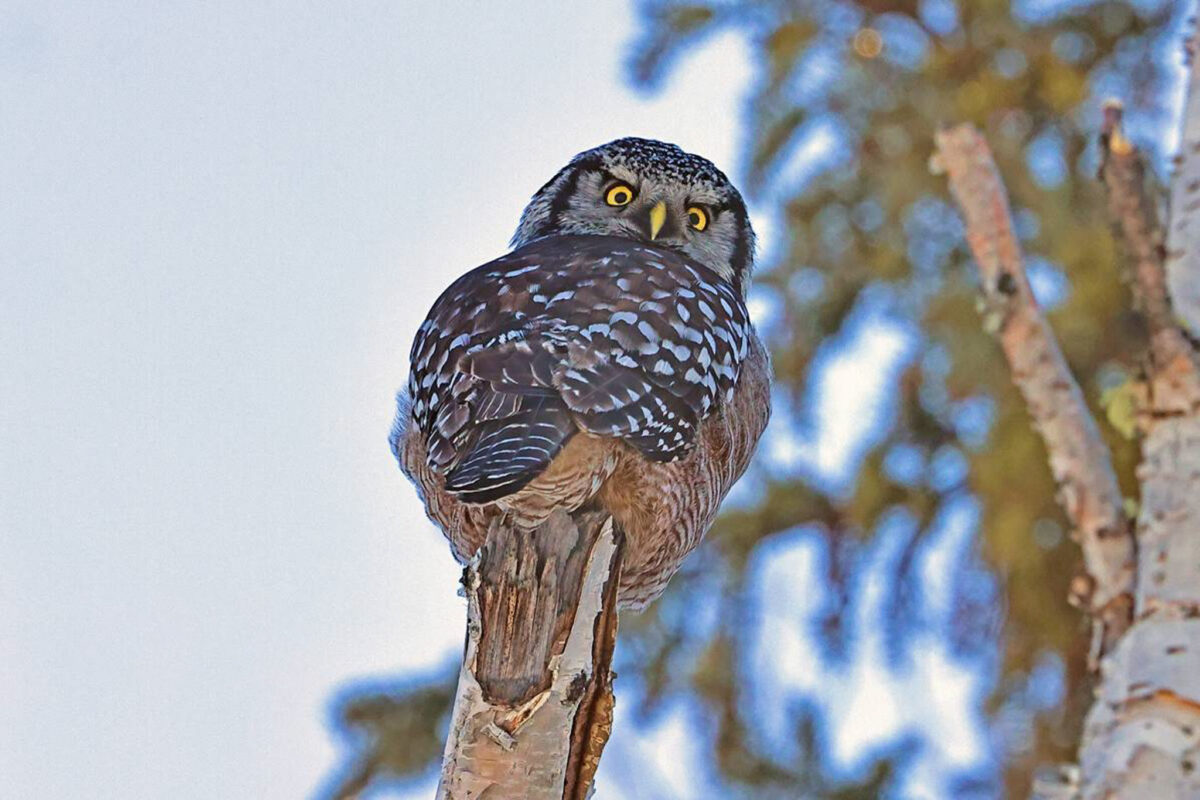Creamer’s Field Migratory Waterfowl Refuge became home to a nesting pair of Northern Hawk Owls for the better part of a year. These solitary and mysterious birds of prey remained a constant and extraordinary presence here on the refuge for humans and wildlife alike. Their visible hunting and nesting activities created an accessible spectacle. Many dedicated local birders and refuge staff were able to document every daily aspect of these owls’ lives from witnessing daily hunting during the late fall and winter, mating, establishing a nesting site, successfully raising young, and battling other local predators for territory throughout the many months of their residence here on the refuge.
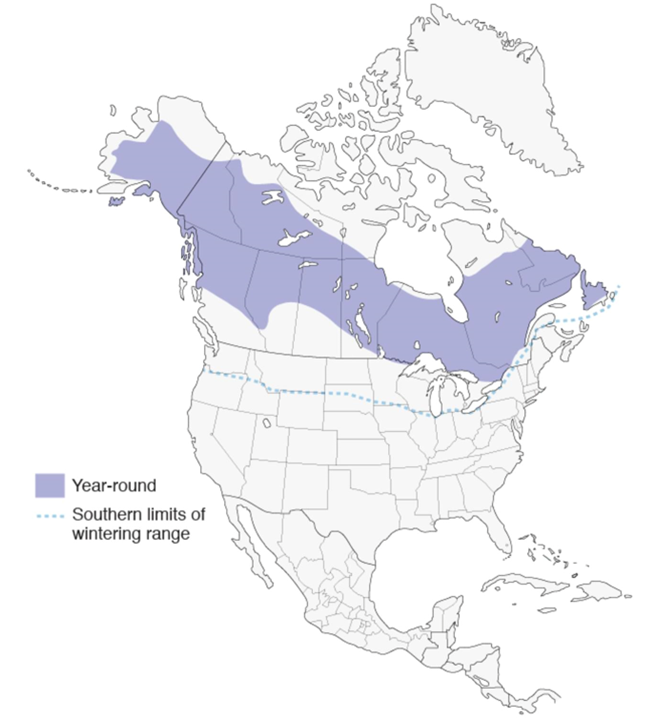
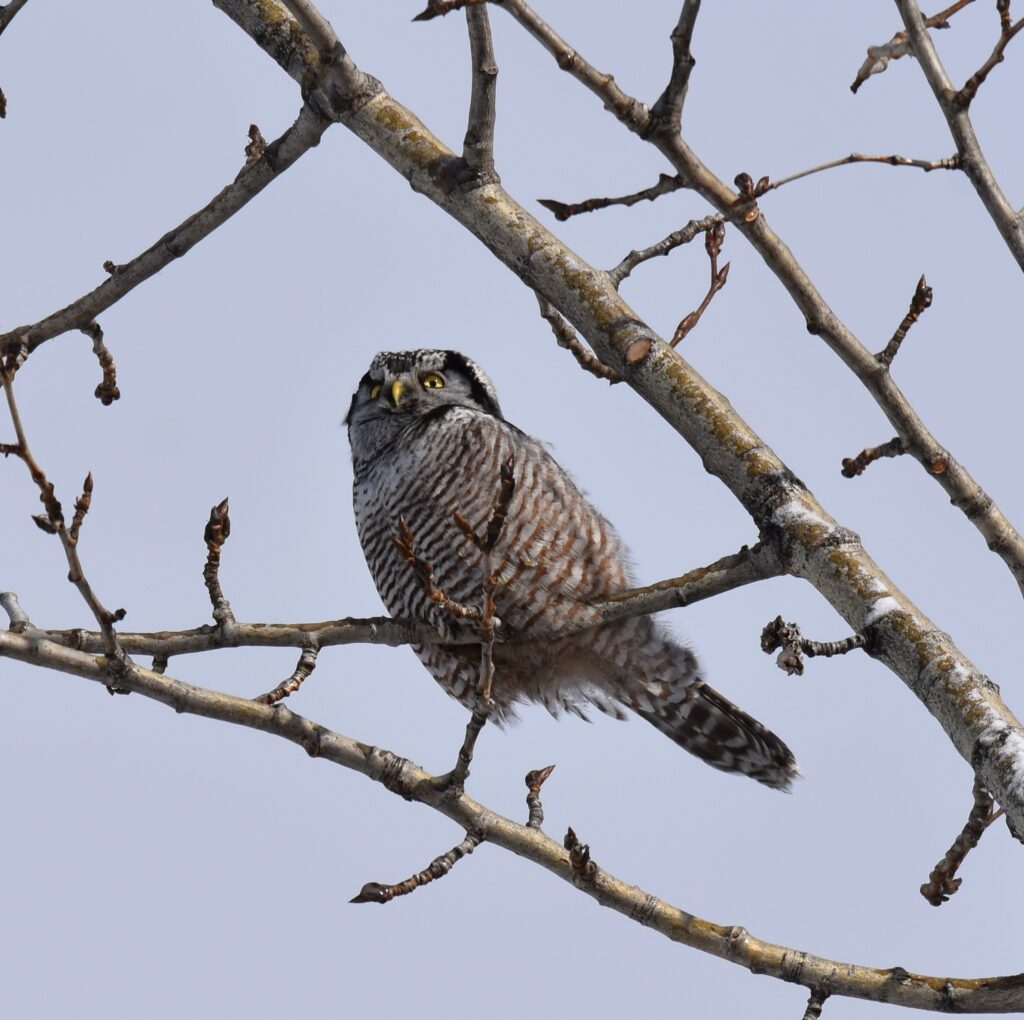
Range and Habitat
The Northern Hawk Owl, Surnia ulula, remains as one of the least-studied birds in North America. The name “hawk owl” comes from its hawk-like body shape, posture, and daytime hunting habits. It is a medium-sized owl at 16″ long and has a long slender tail, black facial disk borders, and brown barring on its underparts. It is truly boreal and even in winter, it rarely wonders to southern Canada or the northern lower forty-eight.
The Northern Hawk Owl is one of five common owl species seen in Interior Alaska along with the Great Horned Owl, the Boreal Owl, the Great Gray Owl, and the migratory Short-eared Owl. The Snowy Owl is a rare visitor, preferring the coastal tundra of northern and western Alaska.
Northern Hawk Owls are found in their preferred habitat: muskeg. Muskeg has a water table near the surface and Alaska’s boggy muskegs are types of wetlands found in cool climates, closely related to landscapes elsewhere known as moors, peatlands, and bogs.

First Sighting and Diet
The first sighting of the Northern Hawk Owl at Creamer’s Field occurred on October 14, 2022, atop the trees alongside the Subsistence Division building or “bunkhouse”. Throughout multiple sightings, the owl was observed hunting in the west fields of the refuge, Seasonal Pond, and in the barnyard. The wide-open spaces punctuated with plenty of tall perches, bring in the owls searching for small mammals (voles, shrews, and young snowshoe hares) and birds. Voles are small rodents and are the mainstay of the Hawk Owl’s diet. Unlike most other owls, the Northern Hawk Owl hunts throughout the day, though they are most active in the early morning and late evening. On the refuge, the owl could be seen flying in the evenings from the west fields over to the Seasonal Pond and disappear into the boreal forest, presumably to a roosting spot.
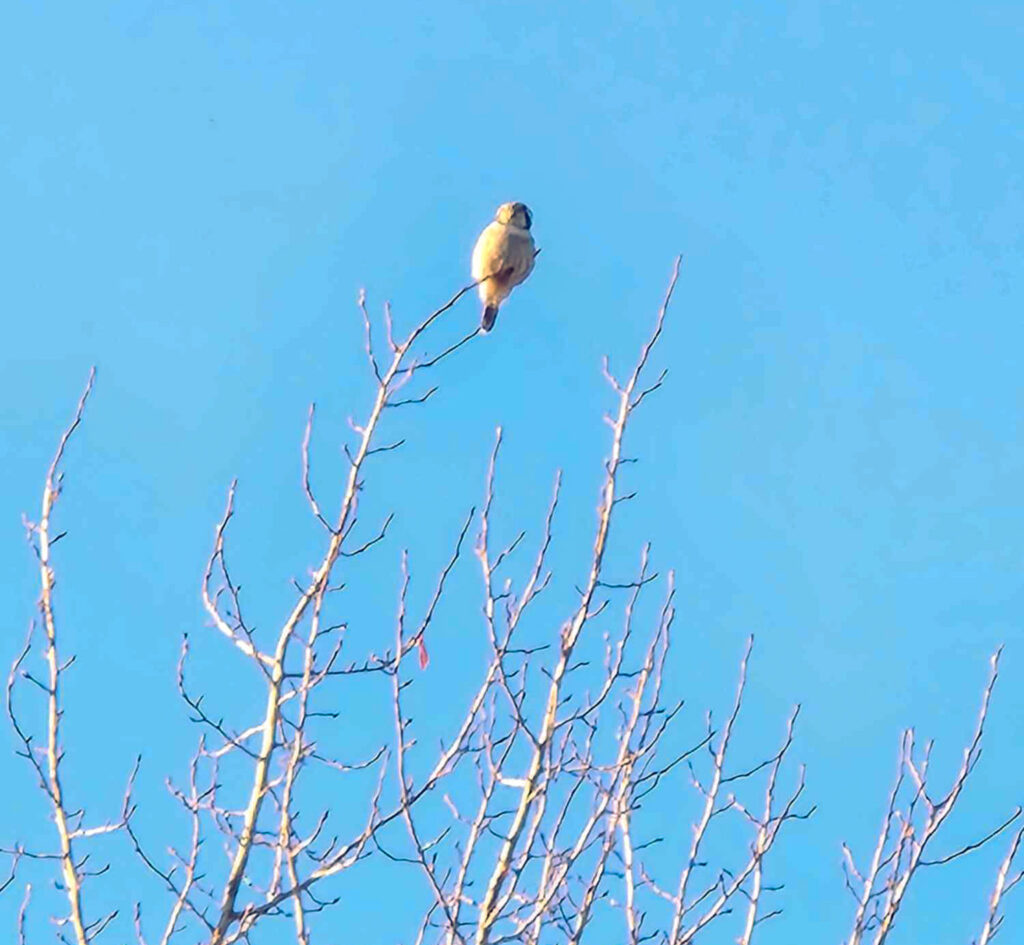
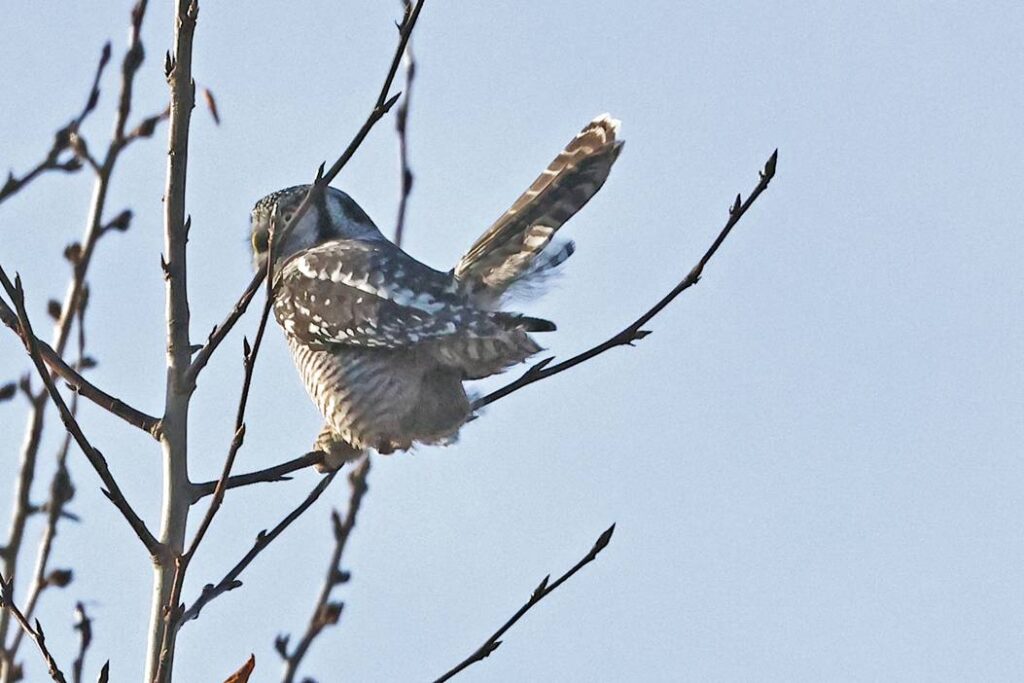
Adaptations
Throughout the winter, the owls must hunt for their small mammal prey, who tunnel underneath the deep snow. These owls are diurnal which means they are primarily active during the day though they can also hunt at night. Owls must listen and watch for signs of activity under the snow. They have sensitive ears and can hear higher frequency sounds than humans by detecting 10-150 millionths of a second difference in the time it takes the sound to reach each of their ear openings. Owls that hunt primarily by sound have asymmetrical ear openings that allow them to pinpoint faint sounds.

Owls also have extraordinary eyesight, and their adaptations allow them to have great binocular vision. Owl eyes face forward and are immoveable, but they compensate for this by their ability to rotate their heads about 270 degrees. Owls have excellent vision both in daylight and at night. Their pupils allow them to discern objects at 1/10th to 1/100th the amount of light that humans need. Once owls hear and see prey activity under the snow, they then swoop down and grab the prey with their sharp talons. Northern Hawk Owls take advantage of abundant prey by caching small mammals to eat later while storing them in tree crevices, holes in trees, and in dense spruce boughs. Like all birds, owls do not have teeth, so the whole animal is eaten. In the gizzard, the digestible soft tissue is separated from the undigestible (fur and bones) is then regurgitated and spit out as a pellet (bottom right photo).

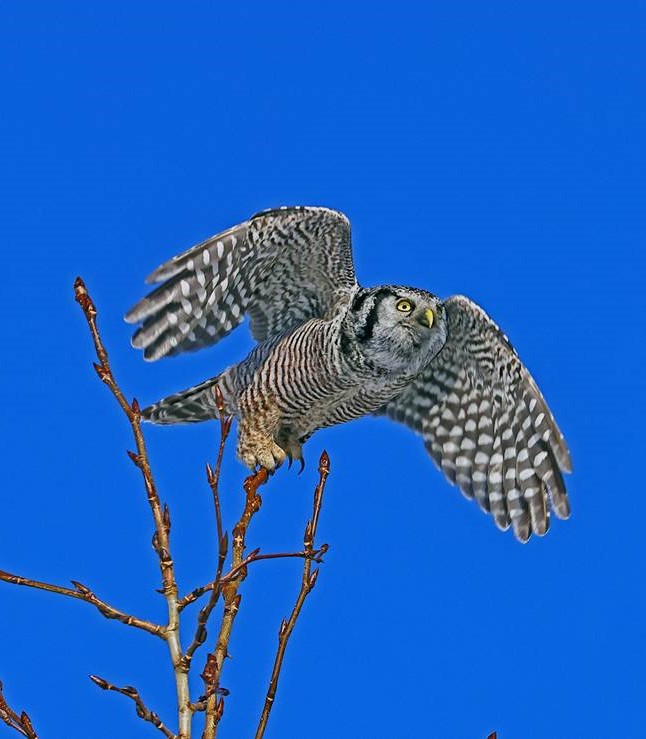
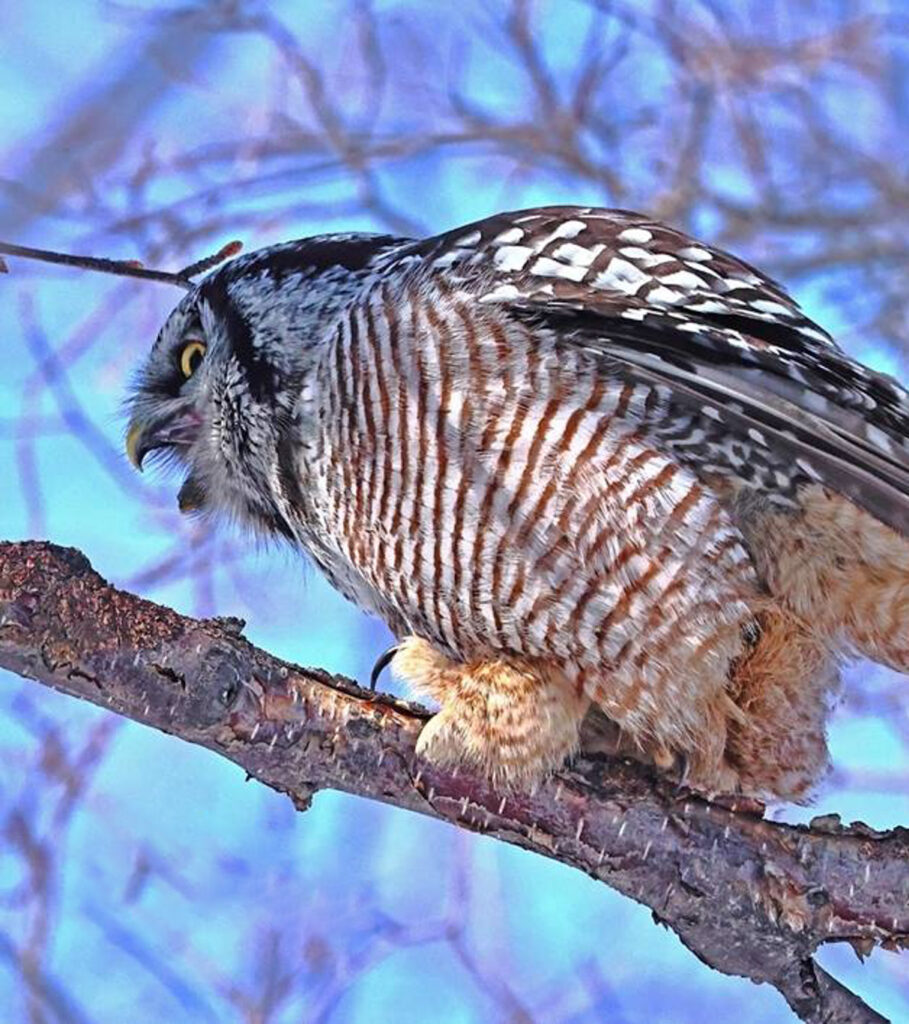
Mating
These owls tend to be solitary year-round but seem tolerant of other birds including other owls within their territory. During the February-March breeding season, hunting, and courting both take place within their established territory. A male trying to court a female will fly in circles with its wings held stiff while singing; then he lands on a prominent perch where he starts to call for a mate with a rolling whistled ulululululul, sound. Once paired, the male offers food to his mate and continues to feed her during incubation. Pairs will stay together for a single breeding season.
Onlookers at Creamer’s Field only spotted a single Northern Hawk Owl throughout the winter. Towards the end of March, a second owl was seen, and they were both spotted perched near each other in the wetland on the birch snags. A determination on sex could not be observed from afar, but most female owls can be greater in mass than males.
First Nesting Attempt
Northern Hawk Owl’s prefer nesting sites located in cavities in decayed trees, open decayed hollows where treetops have broken off, burnt-out stumps, and vacant woodpecker nests. The seasonal wetland area on the refuge was an ideal location for this pair due to the abundance of dead birch trees. This area has experienced increased flooding since 2013, creating a large habitat of thousands of dead birch trees for cavity nesters.
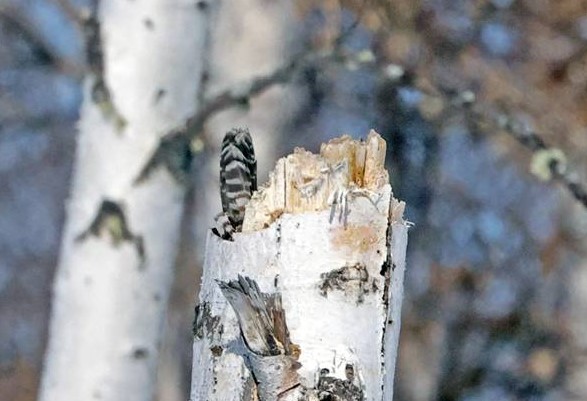

The first nesting site was located by Ted Swem in early April near the middle of the wetland near the Boreal Forest Trail Loop; not easily seen from the trail. This pair preferred open decayed hollows where the treetops had broken off. The birch tree bark has natural preservatives, and the interior wood does not, so as the wood rots, the bark and adjacent wood remains. The owls use this natural bowl for their nest and the floor of the nest cavity for these owls is often composed of decomposed wood, feathers, prey fur, and matted pellets. The female exclusively began sitting on the nest while the male would bring her food.
Threats
The Northern Hawk Owl pair were very protective of their territory and dealt with constant threats. This Northern Hawk Owl pair were very protective of their territory and dealt with constant harassment from wildlife while they were on the refuge. The owls had to intimidate perceived threats and even fight off wildlife on several occasions. Woodpeckers and other smaller birds who got too close to the nesting site would be chased away by the owls. The biggest threat they dealt with was from Common Ravens. Onlookers heard loud warning calls, hissing, saw missing feathers on the owls, bark torn from the top of the nesting site, and witnessed spectacular aerial battles between the male Northern Hawk Owl and the ravens. On April 25, both adult Northern Hawk Owls were observed both perched on snags in the wetland away from their nest. Unfortunately, the ravens were successful in pushing the owls out of their first nesting site.
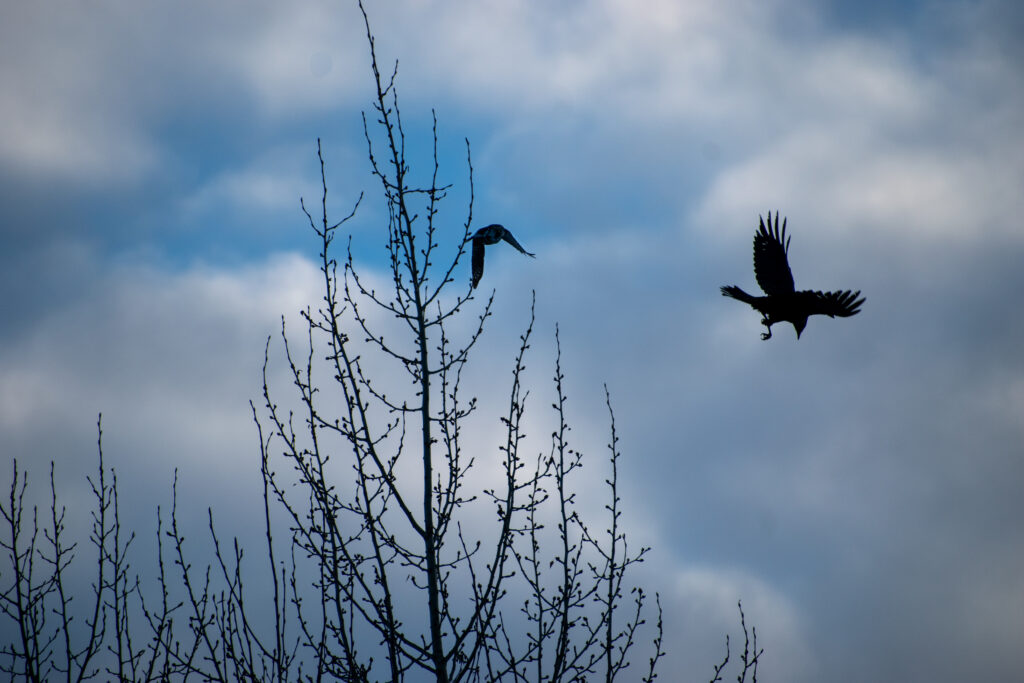

Second Nesting Attempt
With the constant harassment by ravens, the refuge staff and local birders were worried that the owls would be driven from the refuge entirely. Thankfully a few days after being pushed out of their first nest site, the female owl was spotted sitting in a new tree cavity closer to the southern edge of the Boreal Forest Trail loop near stop #16.

Throughout May, the ravens stayed away perhaps due to the Short-billed Gulls nesting in the wetland as well. The gulls would mob the ravens if they got anywhere close to their own nests; the behavior helped benefit the owls and their nesting too.
While the female was tending to the nest, the male was consistently bringing her voles during the month of May. As the female is the only one who incubates the eggs, it is imperative that she had enough sustenance to keep them warm. The mean laying interval is 1.6 eggs per day and the average clutch size for a Northern Hawk Owl is 7 eggs. Incubation begins after the first egg is laid and their incubation lasts around 25-29 days. By mid-May, she was observed sitting higher up in her nest, so onlookers were anticipating a large brood of nestlings soon.
Nestlings
Throughout the first week of June, the female owl was seen draping her wings over the cavity to shield the eggs or owlets from the sun. Finally on June 12, the first 2 owlets were observed!
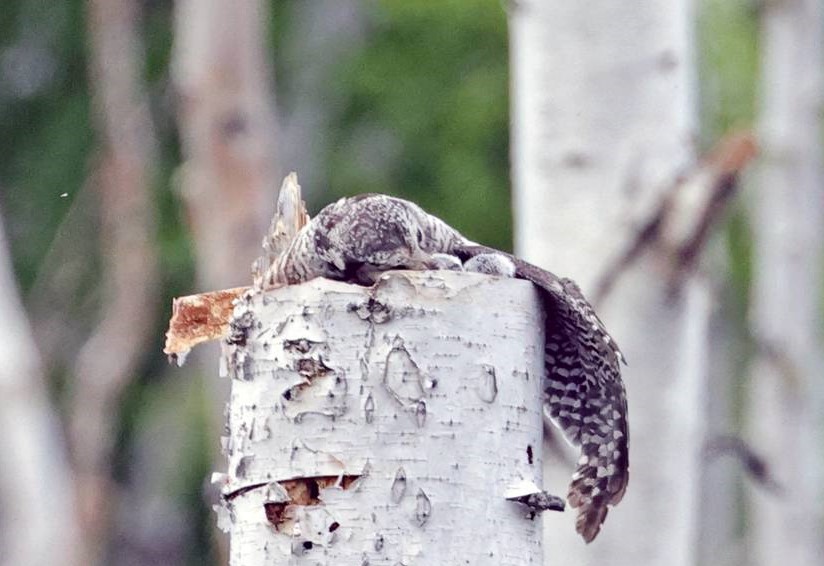
For Northern Hawk Owl nestlings, the female will stay and brood the chicks until they are at least 10-13 days old. While she broods, the male will still be bringing voles and small mammals to feed the nestlings. As the chicks grow bigger, the female will clean pellets and droppings out of the nest. She will begin to hunt for voles and trade off with the male to make sure the chicks are getting the maximum amount of sustenance to grow quickly.
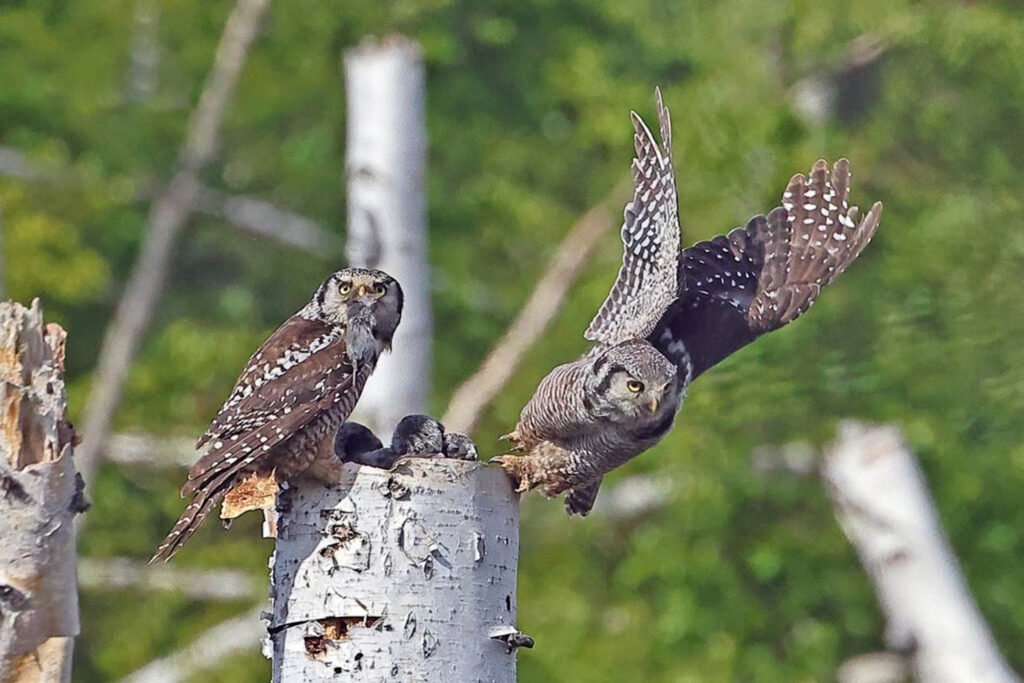
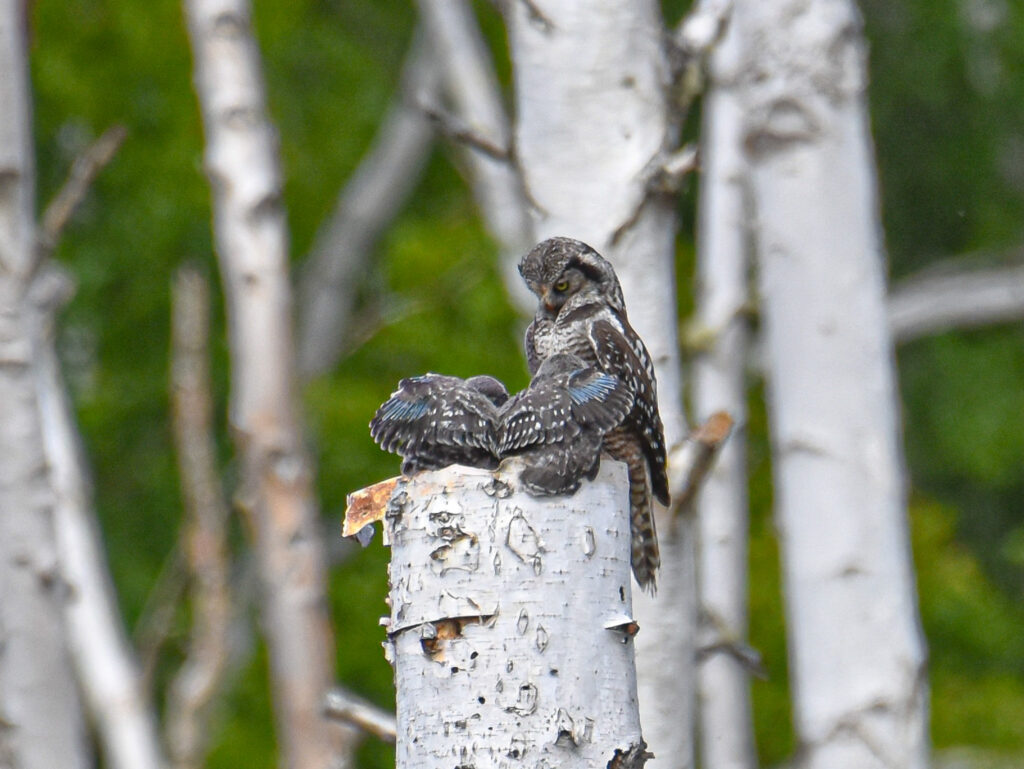
The young leave the nest at 3-5 weeks of age. Of the original 6 nestlings that were seen initially, only 4 were later seen growing in the cavity and eventually leaving the nest. In the first week of July, the 4 fledged juveniles were hanging around the wetland as the adults continued to bring them voles.
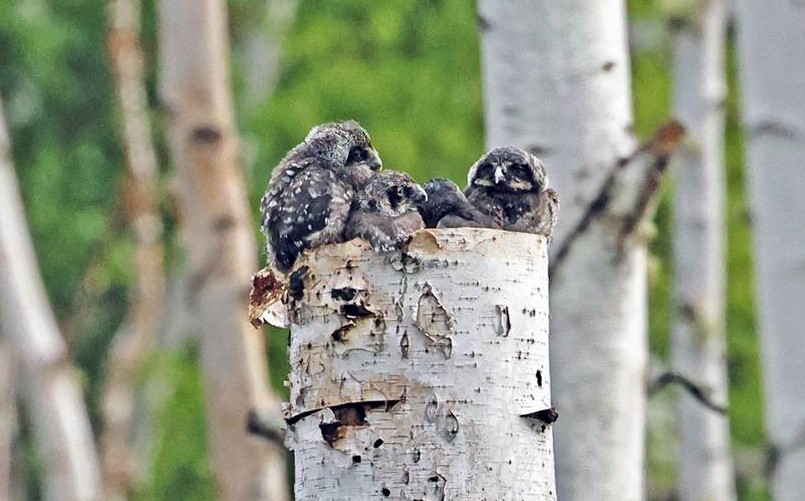
The juveniles practiced flying around the area and if any threats got close, the adults would raise alarm calls and swoop down to intimidate whatever got too close to their young. By the middle of July, all the owls departed the area and were not seen again for the rest of the summer. Once the young Northern Hawk Owls are 2.5-3 months old, they will all begin to disperse to each try and survive on their own during the incoming winter.
We had a hoot of a time!
This nesting pair of Northern Hawk Owls and their young brought much excitement and awe to Creamer’s Field. The special spectacle brought many birders and visitors from all over to come and view this rare northern owl pair and their nesting activities. We will keep a watchful eye on the treetops this winter hoping for the return of these unique northern raptors once again.
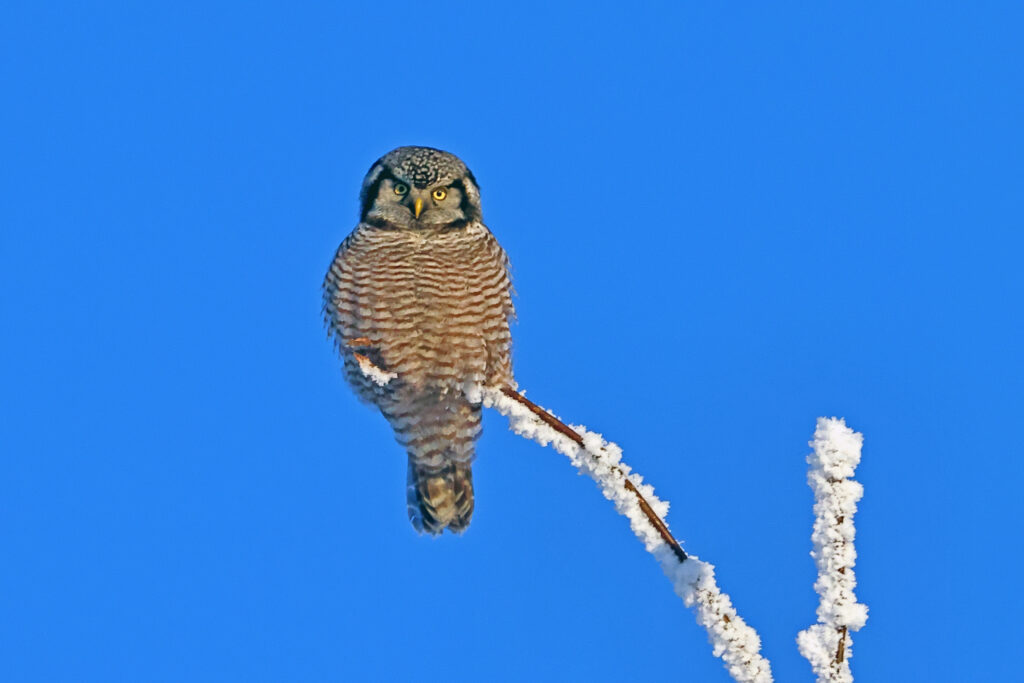
Thank you to all the visitors, birders, biologists, researchers, and photographers who contributed their work!
Resources:
“Alaska’s Owls”. Alaska Department of Fish and Game (ADF&G). https://www.adfg.alaska.gov/index.cfm?adfg=owls.main. Accessed 11 Sept 2023.
Duncan, J. R., and P. A. Duncan. 1998. Northern Hawk Owl (Surnia ulula). The Birds of North America, No. 356 (A. Poole and F. Gill, eds). The Birds of North America, Inc., Philadelphia, PA.
“Northern Hawk Owl, All About Birds, Cornell Lab of Ornithology”. Allaboutbirds.Org, 2023, https://www.allaboutbirds.org/guide/Northern_Hawk_Owl/overview. Accessed 12 Sept 2023.
“Sounds Wild Episode – Radio Program “. Alaska Department of Fish and Game (ADF&G https://www.adfg.alaska.gov/index.cfm?adfg=soundswild.episode&id=muskeg#:~:text=They%20are%20a%20type%20of,water%20table%20near%20the%20surface. Accessed 11 Sept 2023.
Taras, Mike E. et all. The Alaska Owlmanac: A Guide to the Identification, Habits, and Habitat of Ten Owl Species Found in Alaska. Alaska Department of Fish and Game (ADF&G), Division of Wildlife Conservation, 2004.
Information and photos compiled by Melanie Graeff, the Programs & Events Coordinator with the Friends of Creamer’s Field.

